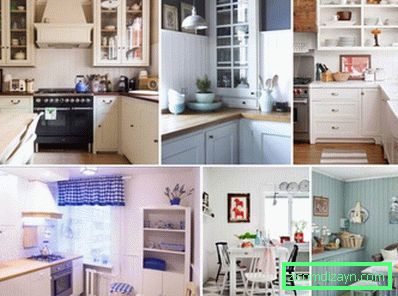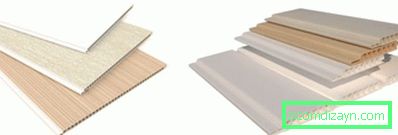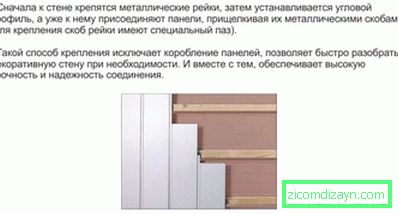Plastic panels in the kitchen apron and wall decoration
Traditionally, the apron and walls of the kitchen are faced with ceramic tiles, but plastic panels can counter many things against this material - both in terms of design and practicality. To understand why this is so, consider the classification of the material.
What are the plastic panels for the kitchen
Plastic panels for the kitchen are made of extruded polyvinyl chloride (PVC). They are classified into types according to dimensions:
- Lining PVC: 10-12.5 cm wide, up to 3 m long, usually monochrome;


- Actually wall plastic panels: width 15-50 cm (more common 25 cm), length up to 3 meters, seamless connection;

- PVC sheet: 0.8-2.03 meters wide, 1.5-4.05 meters long, 1 to 30 mm thick; with a smooth, smooth surface, matte or glossy.

Pluses of plastic panels
The walls and apron of the kitchen, faced with plastic panels, have the following advantages:
- The ease of construction, which makes PVC fastening incredibly simple;
- Speed of fastening - kitchen panels made of plastic are fastened 10 times faster than ceramic tiles;
- The apron and the plastic walls are incredibly easy to care for - they can be wiped with napkins or washed with standard detergents (non-abrasive);
- Plastic panels for the kitchen are made of solid PVC, resistant to high temperatures (sensitivity threshold - 120 °);
- Modern decoration of plastic allows you to create an apron kitchen with any design - with unusual prints, three-dimensional patterns or original colors, often used and transparent wall panels;
- And the main advantage - the cladding of walls and an apron of plastic - is budgetary and available.
The disadvantages of plastic finishing
Of course, the wall panels made of plastic have their drawbacks - in most cases they are a counterbalance to affordable value. Among the main negative characteristics of plastic can be attributed:
- A small margin of safety, low resistance to wear;
- The possibility of damage to the facial decorative panel due to prolonged contact with detergents or ultraviolet rays;
- Combustibility in contact with an open fire - this should be taken into account when the kitchen apron is located.
There is another nuance - wall PVC panels for the kitchen must certainly have all the certificates, including hygienic, confirming the production of material from a safe raw material that does not emit harmful substances when heated.
Do not think that finishing the kitchen with PVC panels is impractical or unprofitable. The main thing is to choose the right material.
Recommendations for the choice of wall panels
When choosing kitchen wall panels, you should follow these recommendations:
- The dimensions of the plastic sheet or panel must be greater than the area of the apron - so that the material goes behind the cabinets and is slightly below the working surface.
- If you plan to place the plastic close to the hob, do not forget to make sure that the material has fire safety certificates.
- The color scale is selected depending on the characteristics of the kitchen: large drawings and dark colors are preferable in spacious rooms, and in smaller ones wall panels with small floral ornament or quiet light tones will be more appropriate. A win-win option is a light one-color or wood-imitating panel without gloss.

- You can choose wall panels of unique design textures: metallized for hi-teka, brick for minimalism, wood - for classics, imitation of old images or ornaments - for vintage.
With the help of plastic panels in the apron and on the walls, you can even visually expand the kitchen space, if they are installed horizontally, and "lift" the ceiling with the vertical arrangement.
Advice! A plastic apron should be completed with a curb that protects the joints of the panels from moisture and contaminants.

We mount wall panels with our own hands
To fix the panels in an apron or on a wall you will need the following tools:
- Drill-drill and screwdriver;
- Pencil, tape measure;
- Plumb bob, or level;
- Building stapler, staples to it;
- Glue;
- Profile of metal or wooden beams to create a crate;
- Suspension;
- Dowels, self-tapping screws;
- The PVC panels themselves are of the chosen type and size.
Method 1. Plastic panels can be glued directly to the wall. This is an easy-to-implement method, but you will not be able to dismantle the material without damage if necessary. In addition, gluing is possible only if the kitchen walls are flat and their difference is not more than 1 centimeter. In addition, fix the panels in the corners with screws.

Method 2. It is possible to screw the material directly to the wall - for this, mounting holes are drilled, the panel is fixed, and the places where the screw heads are located are masked with plugs. For this method of fastening, it is necessary to prepare the wall in advance: to repair cracks and potholes, to align, primed.
Method 3. Plastic can also be installed on the crate - in the beginning, the panels are screwed (attached) to the profile or strip, and then are attached to the wall.

Method 4. The installation of plastic panels using metal profiles and staples is done using a similar technology using a billet.

Plastic panels for cladding kitchen apron and walls - it's an unlimited design choice, due to which your kitchen will be transformed. You can choose from the widest palette of colors - from white to black, smooth or textured surfaces that mimic skin, fabric or any natural material, volumetric drawings, photo printing, semi-matt, matte, glossy or mirror coating. And if you want, the plastic panel is easy to change, because the material is budgetary. More details about the plastic apron can be found in the material: Plastic apron - information for the buyer.